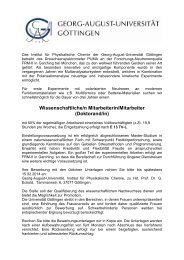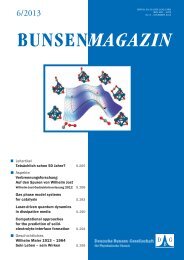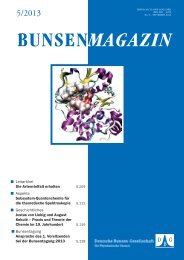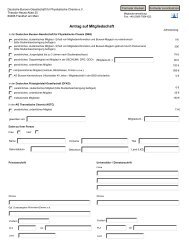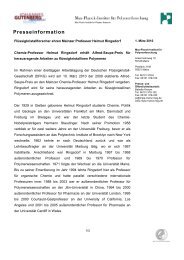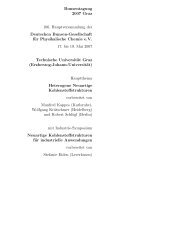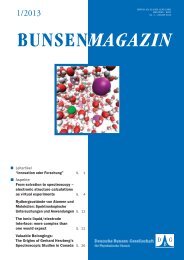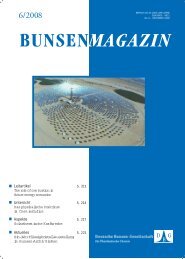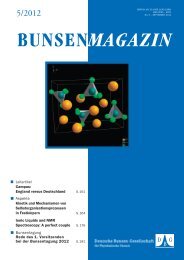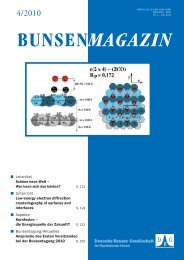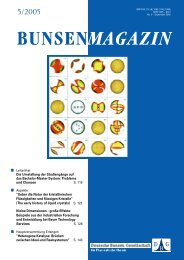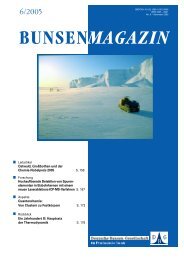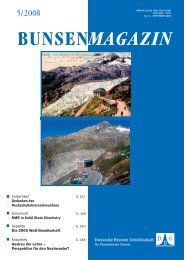BUNSENMAGAZIN - Deutsche Bunsengesellschaft für ...
BUNSENMAGAZIN - Deutsche Bunsengesellschaft für ...
BUNSENMAGAZIN - Deutsche Bunsengesellschaft für ...
Sie wollen auch ein ePaper? Erhöhen Sie die Reichweite Ihrer Titel.
YUMPU macht aus Druck-PDFs automatisch weboptimierte ePaper, die Google liebt.
UNTERRICHT<br />
can be met even for the strongest dipole-dipole couplings<br />
(w D » 2p·35.5 kHz). This line-narrowing effect upon increasing<br />
rotation frequency w R on the 1 H NMR spectrum can be understood<br />
as being due to an increase in the spin-pair character of<br />
the 1 H- 1 H dipolar coupling. 20 Since in most cases the remaining<br />
spins are further away, corresponding remote couplings can<br />
effectively be ‘spun out’ and only the strongest dipolar couplings<br />
that originate from protons at close spatial proximities<br />
are retained. This rather simple picture indeed emanates from<br />
an extensive theoretical treatment of multi-spin systems under<br />
fast MAS, combining Floquet theory and perturbation theory.<br />
20,25 The higher-spin contributions are found to scale with<br />
increasing powers of the inverse rotor frequency and therefore<br />
become less important at highest w R .<br />
Magic angle spinning, however, modulates the spin interactions<br />
periodically which means that it generates so-called rotational<br />
echoes and the NMR data acquisition can be performed<br />
in two ways: 15-18 If only the echo-height is monitored (e.g. in<br />
a rotor-synchronized acquisition) a single line results in the<br />
NMR spectrum for each spectroscopically resolved site and<br />
(most) information about anisotropic couplings is lost. On the<br />
other hand, if the whole echo-train is monitored, a (spinning)<br />
sideband pattern results that contains information about the<br />
anisotropic couplings, yet with spectral resolution of the different<br />
sites (Fig. 2). This is important for a precise structural<br />
elucidation based on dipole-dipole couplings as well as using<br />
this interaction to study molecular dynamics. Moreover, on account<br />
of its angular dependence, molecular motion leads to an<br />
averaging of observable dipolar couplings. Monitoring this reduction<br />
of the dipolar coupling thus allows an identifi cation of<br />
dynamic processes present in the sample. Indeed, this is well<br />
known, e.g., from NMR investigations of liquid crystals, where<br />
the reduced NMR couplings yield site-specifi c values for the<br />
Maier-Saupe order parameter S = . 27 The<br />
extreme case is given by a solution, where fast isotropic tumbling<br />
of the molecules (Brownian motion) leads to an almost<br />
complete averaging of line-broadening due to dipolar couplings<br />
and other anisotropic interactions.<br />
2.3 DOUBLE-QUANTUM NMR<br />
The Hamiltonian that describes a particular spin interaction can<br />
be separated into a space and a spin part. While MAS solely<br />
affects the space part, it is possible to manipulate the spin<br />
part by radiofrequency pulse techniques. 20,28,29 Depending on<br />
the applied pulse sequence, a given spin interaction can be<br />
selectively switched on and off in order to discriminate different<br />
contributions to the desired spectral information. In order<br />
to obtain structural information, homonuclear dipolar couplings<br />
that relate protons of different chemical entities are highly informative.<br />
They can be conveniently probed applying so-called<br />
double-quantum MAS NMR spectroscopy, 30 which relies on<br />
the selective excitation of quantum-mechanically “forbidden”<br />
double-quantum coherences (DQC). In fact, this simply means<br />
that such double-quantum coherences cannot be detected by<br />
conventional means but have to be converted into detectable<br />
single-quantum (SQ) signal. Considering a pair of two protons<br />
(each spin-1/2), DQCs can easily be generated by two successive<br />
90° pulses (cf. fi gure 3): the fi rst 90° pulse labels the spins<br />
64<br />
BUNSEN-MAGAZIN · 11. JAHRGANG · 2/2009<br />
with their 1 H chemical shifts while the evolution under the dipolar<br />
coupling produces so-called two-spin correlations, which<br />
are turned into DQCs by the second 90° pulse. In other words,<br />
a DQC means that both coupled protons change their spin state<br />
simultaneously in a correlated fashion so that the sum of changes<br />
in magnetic quantum number amounts to two.<br />
Figure 3: Generation of double-quantum coherences (DQCs) by two successive<br />
90° pulses acting on a quadruple spin system (spins A-D). Note that a<br />
dipolar coupling D ij > 0 is required. 30<br />
After excitation, the DQC evolves during an incremented time<br />
period t 1 and is then converted into observable signal that can<br />
be detected in an acquisition period. If this pulse sequence<br />
is applied as so-called 1D-experiment (e.g. t 1 is constant), the<br />
resulting 1 H NMR spectrum refl ects pair-wise dipolar-coupled<br />
proton sites that experience suffi ciently strong dipolar couplings.<br />
As stated above, molecular motions (like e.g. axial C 3 -<br />
rotation of methyl group protons) can reduce the dipolar coupling<br />
among two spins and thus lead to signal losses in such<br />
DQ-fi ltered spectra.<br />
Figure 4: Schematic representation of the back-to-back pulse sequence for<br />
double-quantum excitation. The t 1 period can be kept constant (1D version,<br />
DQ-filtering) or incremented in either a rotor-synchronized fashion (e.g. an increment<br />
corresponds to a rotor period (t R = 1/rotation frequency) or in arbitrary<br />
increments. The sinusoidal wave reflects the rotor modulation due to MAS. 30<br />
Effective averaging of the underlying dipolar couplings and<br />
hence missing of peaks in comparison to the regular 1D- 1 H<br />
MAS NMR spectrum, typically indicate motions that are fast<br />
on the NMR time scale (e.g. motional correlation times below<br />
μs). This can be used to detect mobile proton sites. For the<br />
investigation of local structures, however, the 2D version is<br />
preferred. In such a two-dimensional experiment, DQCs due<br />
to pairs of dipolar coupled protons are correlated with SQCs<br />
resulting in characteristic correlation peaks. DQCs between<br />
like spins appear as a single correlation peak on the diagonal<br />
while a pair of cross-peaks that are symmetrically arranged<br />
on either side of the diagonal refl ect couplings among unlike<br />
spins (cf. fi gure 5). 13a



